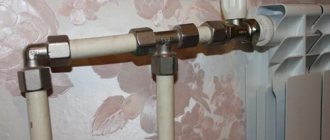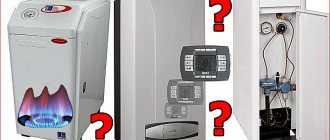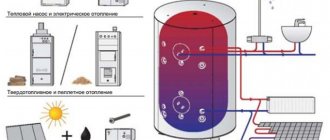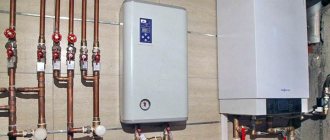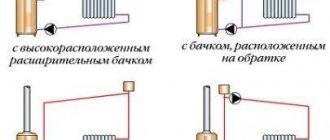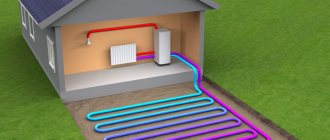Rating: 1,688
Autonomous heating is a heating system that is able to warm up each room or the entire house. The most popular apartment heating in an apartment building is individual gas heating.
The reason for this is the relatively low price and environmental safety. Although there is also electric heating in the apartment.
Installation of apartment heating
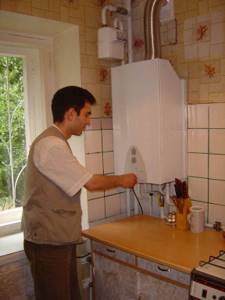
How relevant is this method of maintaining a comfortable temperature in an apartment? At first glance, it seems that the costs of purchasing equipment, installing and maintaining it will significantly exceed the costs compared to central heating. However, by making simple calculations, you can make sure that gas apartment heating will compensate for the initial costs over three to five operating seasons.
To ensure the objectivity of these conclusions, one should consider the positive and negative aspects of installing an autonomous system.
Advantages of apartment heating:
- The ability to set a comfortable temperature level in the room yourself. For central heating, it is possible to implement such a function - it requires the installation of a special meter, which must be approved by many authorities;
- Reduced operating costs for coolant. On average, apartment heating systems cost residents 40-50% less than a central system;
- Complete independence from the work of the heat supply management company. This applies to scheduled and emergency repairs, and non-compliance of the coolant temperature with standards.
The main negative point for any apartment heating system is the high initial cost of purchasing equipment and the complexity of its installation. In addition, to disconnect from the central system and install an autonomous one, it is necessary to obtain the appropriate permits. All concerns about routine maintenance and equipment repairs also fall on the shoulders of the apartment owner.
Installation of individual heating
Legal aspects

Legal approval is one of the most difficult issues
The process of switching to autonomous heating itself must begin with obtaining permits.
An approximate operating algorithm would be like this:
- To begin with, the technical possibility of disconnecting from centralized heating is clarified. This point is the most difficult, since operating organizations are extremely reluctant to agree to such a step.
Note! The likelihood of a judgment in your favor will be greater if you contact a lawyer who specializes in such issues. Collective applications from the entire house or entrance also give good results.
- Next, we contact the design organization, which must develop technical conditions for connection, including drawings for gas pipes, placement of heating circuits, etc.
- The next stage is fire supervision. If the building is made of non-combustible materials (brick, concrete), then obtaining a certificate usually does not cause problems.

Actual disconnection from central heating can only be carried out after obtaining all permissions
- Then we purchase equipment (we will talk about the choice in the next section) and contact the installation organization. Its representatives are obliged to request from you certificates of compliance of the boiler with accepted standards, therefore, when purchasing a unit, you need to pay special attention to this.
- Next, the installation itself is carried out, the boiler is connected by gas industry specialists, as well as the equipment is registered and serviced. After this, the operating organization should receive a notification from you about the transition to autonomous heat supply to the apartment.
Note! Document forms must be agreed upon with the organization to which you will provide them. Of course, the instructions presuppose the existence of a unified state standard for the preparation of such papers, but very often organizations establish their own internal rules.
Selecting a heating device
For the apartment heating system, you need to choose a hot water boiler. And here we need to decide both the power of the device and the type of fuel used - gas or electricity.
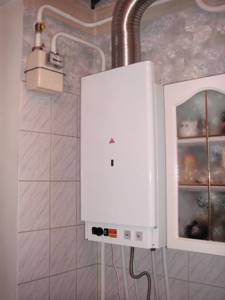
A compact gas boiler can easily heat a standard apartment
As for productivity, everything is quite simple: to heat each square meter of area you need at least 100 kW of boiler power. Therefore, an apartment with an area of 50 m2 requires a device of at least 5 kW.
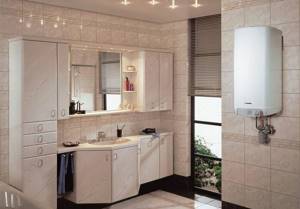
Electric heating boilers (pictured) are less economical, but more convenient to use
As for gas and electricity, the choice here is more difficult to make. To analyze the strengths and weaknesses, we structured the information in the form of a table:
| Boiler type | pros | Minuses |
| Gas |
|
|
| Electric |
|
|
However, gas devices are still more popular, so they will most likely be recommended to you. On the other hand, electric boilers can also be installed in non-gasified buildings.
Peripheral installation
Finally, for heating it is necessary to install piping and radiators.
And although there are very few differences from centralized heating, they are worth paying attention to:

Connection of polymer pipeline and radiator with fittings
- A feature of individual heating is low pressure in the system and the absence of temperature changes. This leaves its mark on the process of selecting components.
- So, instead of steel pipes, you can use polymer or metal-plastic products. They are practically not subject to corrosion, but at the same time have sufficient temperature and deformation resistance.
Note! Some of the pipes can be laid in the floor screed, ensuring heating of the lower layer of air. This will be more rational than installing heated floors connected to central heating radiators.
- Radiators can be less durable, but more efficient in terms of heat transfer. Thus, it is the installation of apartment heating that allows the use of aluminum batteries: since water hammer during pressure testing does not threaten the circuits, a stability of 25 atmospheres should be enough.

Piping diagram
- Also, when installing individual heating, the use of bimetallic radiators is justified. Due to the high heat transfer of such products, it is possible to maintain a lower temperature in the pipes, which allows you to avoid overpaying for gas even in the cold season.
As for assembling the circuits, no difficulties should arise here: we connect the metal parts either with welded or threaded fittings, and to fasten the polyethylene pipes we use high-temperature soldering technology.
Advice! Before starting the system, it must be checked for leaks.
Registration of permission for apartment heating

There is a misconception that issuing permits for an apartment with apartment heating is almost impossible to do. However, to do this you only need to know the basic laws and adhere to technical standards.
According to paragraph 44 of the Government of the Russian Federation Resolution No. 307, gas boilers with the following characteristics are allowed for installation as heating equipment in apartment buildings.
- Closed combustion chamber;
- Device for monitoring the state of the flame in a gas burner - automation system;
- The operating temperature should not exceed 95°C, and the maximum pressure in the pipeline is 1 MPa.
To select the optimal boiler model, it is recommended to contact the gas management company that services the house. Their representatives must provide requirements for this equipment.
Obtaining Technical Conditions from Gorgaz
To do this, you must provide a package of documents confirming ownership of the premises - a passport from the BTI, a purchase and sale agreement, personal data. Within 14 days, representatives of the organization are required to issue specifications, which include an apartment heating scheme.
You must obtain permission from the fire department, which will inspect the ventilation ducts in the house. If the project initially included the installation of gas equipment, there will be no problems with this document.
Project part
Having received the technical conditions and permission from the fire service, you need to find a design organization to draw up an autonomous heating plan. These services are offered by a management organization or any other commercial company that has the appropriate certificates and permits. You cannot do this part of the work yourself, since houses with apartment heating must comply with current safety standards.
The project document contains an apartment heating scheme, a list of equipment and consumables. For each of them there must be a passport, and in case of its absence, technical information confirmed by the manufacturer and seller. If the house previously had central heating, then the risers are most often left. The plan indicates the location of disconnection from the network, the location of the gas boiler, the diagram of the main line and radiators.
Installation of apartment heating
The entire package of documents is submitted to the administration, which must verify their compliance with technical conditions. After receiving a positive decision, you can begin installing the equipment. It is noteworthy that most reviews about apartment heating at the design stage have a negative connotation, since bureaucracy and paperwork takes a lot of time and money.
It is prohibited to connect the boiler to the gas line yourself. This should only be done by city gas representatives.
Having installed the elements of gas apartment heating, you can proceed to the stage of agreeing on the time of connection to the main line. Representatives of the management company must check the condition of the installed system and issue a certificate of compliance. Then the boiler is connected to the gas pipe and the integrity and correct operation of the system are checked.
Feasibility analysis
Why is central heating ineffective?
Today, most apartment buildings have central heating systems installed. At the same time, only radiators and supply pipes are placed in the apartments, and the coolant is heated at special enterprises (boiler houses and thermal power plants). These enterprises can be located at a considerable distance (up to several kilometers) from the point of heat consumption, which determines the key disadvantages of the system.
The low efficiency of central heating is explained by the following factors:
- Firstly , quite a lot of boiler houses use outdated water heating and steam generating equipment with low efficiency. At the same time, burning large amounts of fuel leads to increased financial costs, and huge volumes of carbon monoxide and other combustion products are released into the air.

The older the generating equipment of the boiler room, the higher the heat loss
- Secondly , transporting the coolant over long distances leads to its temperature being significantly reduced. Heat loss is especially high in winter, during the most active heating period. They are trying to partially compensate for them by increasing the temperature of the water supplied to the pipes, but this again leads to a reduction in costs.
Note! According to SNiP, all external pipelines must be equipped with heat-insulating casings. In practice, from a third to a half of heating mains do not have a high-quality heat-saving circuit, so that CHP plants often heat not so much apartments as the environment.
From the point of view of the recipient of heating as a service, the centralized scheme is also very inconvenient:
- On the one hand, the temperature inside the room is almost impossible to regulate either up or down. So the situation is quite real when you will be forced to wrap yourself in woolen sweaters, waiting for the thermal power plant to raise the temperature of the water in the pipes.
- On the other hand, the stumbling block is the beginning and end of the heating season. Yes, there are certain standards that stipulate the inclusion of heating equipment, but they are not flexible, and therefore in late autumn we are freezing for at least a week, waiting for the heat to be given. Well, in the spring you have to open the windows, since the batteries don’t turn off right away either.

Everyone has to freeze from time to time
However, most often the transition to apartment heating is still determined by financial considerations. Agree, it is much more logical to independently control the microclimate in the room, and pay only for fuel used for its intended purpose, and not finance the transportation of hot water through uninsulated pipes.
Advantages and disadvantages of apartment heating
Before deciding to install autonomous heating, it is necessary to analyze its pros and cons.
The strengths of this technology include:
- Fairly quick payback . By saving on energy costs, you can completely “break even” within five to seven years of operating the system.
Note! These terms are valid only in the case of rational use of heat. If the boiler constantly operates at maximum power, and you open the windows to reduce the temperature (and even more so, turn on the air conditioner), then the savings will be close to zero.
- Comfortable microclimate adjustment . You set the appropriate temperature in the room yourself, and the boiler will automatically maintain it. The highest quality models can be connected to room thermostats, so that the degree of air heating will not depend on the outside temperature.
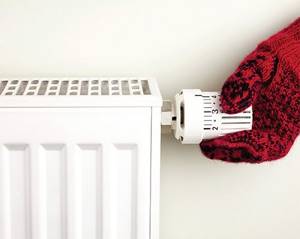
The ability to adjust the temperature yourself is very convenient
- Environmental friendliness . Modern models of heating boilers are characterized by the most complete combustion of fuel, which allows minimizing the volume of emissions into the atmosphere.
- Reduced construction costs . Data Plus is relevant primarily for construction companies: when incorporating apartment heating into a project, there is no need to allocate funds for the installation of heating mains and connection to the main line.
Of course, the system also has disadvantages:
- Firstly , the price of the equipment itself is quite significant. For many, such a one-time investment will be “unaffordable”, so they will either have to take out a loan with all the attendant risks, or save money for several months.
- Secondly , the installation of heating equipment in buildings where centralized heating was previously installed is associated with very labor-intensive bureaucratic procedures.
It is better to entrust the installation and adjustment of gas equipment to professionals
- Thirdly , both during installation and operation of the system, it is necessary to pay close attention to safety issues. This requirement is especially relevant for gas boilers: you should not install them yourself, since only employees of certified services have the right to work with gas equipment.
Choosing an apartment heating scheme

A correctly drawn up project for houses with apartment heating should include the location of pipelines. For apartments, a two-pipe circuit with parallel connection of radiators is most often used.
If the area of the room is not large (up to 60 m), then you can use a single-pipe circuit (Leningrad), in which there is no return pipe, and the batteries are connected in series. This task is best handled by specialists. But the apartment owner also needs to know the basic requirements for drawing up a diagram and its calculation:
- Boiler power . If the room has good thermal insulation of the walls, then when choosing heating equipment you can use a ratio of 1 kW per 10 m² of area. For regions with extremely low temperatures in winter, 15-20% can be added to this figure. That is, under normal conditions, an apartment with an area of 70 m² requires a boiler with a capacity of at least 7 kW. The best option would be 10 kW equipment. This applies to all types of houses in which apartment heating is planned.
- Boiler installation location . It should be installed in the kitchen, since this is the room that best meets the requirements and where the ventilation ducts are located.
The boiler cannot be installed in a bathroom or living room. This is a gross violation of the norms. To set the optimal temperature regime, it is recommended to connect temperature sensors located in the rooms to the boiler. With their help, you can significantly reduce gas consumption, which is the main condition for any apartment with apartment-by-apartment heating.
Popularity of the heating system
For the first time, the population of Western Europe began to use individual heating. Although the leadership in installing such heating was given to the Italians. Northern countries, such as Scandinavia and Germany, also joined them. In 1999, for the first time in the Russian Federation, the idea arose to transfer apartment buildings to an individual type of heating.
With the help of the Japanese, who provided their knowledge in the field of installation and maintenance of devices and the opportunity to save their money, more and more of the Russian population began to respond to the idea of \u200b\u200bgovernment bodies regarding the installation of heating. As a result of numerous refusals from the usual type of heating systems, new SNIP requirements began to be developed.
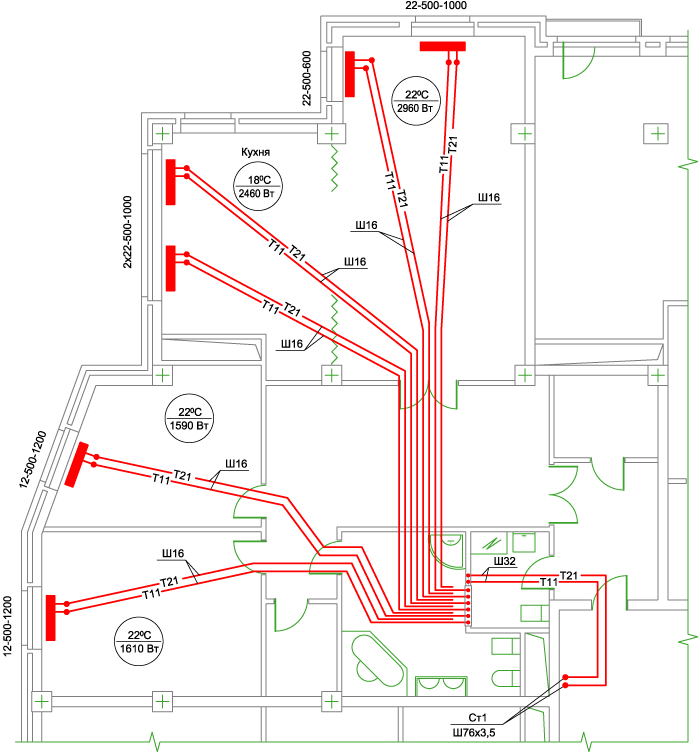
Apartment heating system
Selection of equipment for apartment heating
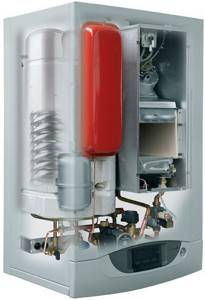
The basis for individual apartment heating is the choice of the right boiler. It is best to install pyrolysis models whose efficiency is as close as possible to 100%. Mandatory components of the heating system are a centrifugal pump and an expansion tank. Currently, you can purchase gas boilers that have these elements in their design.
When reading reviews about apartment heating, you can often come across comments about problems with the operation of the equipment. This is often due to a discrepancy between its parameters and operating conditions. Therefore, when choosing a boiler, you need to pay attention to the following characteristics:
- The presence of an expansion tank and pump in the design;
- Device power;
- The degree of regulation of the heating level of the coolant and water for hot water supply;
- Boiler manufacturer and cost. The products of NAVIEN, BERETTA, PROTHERM and VAILLANT have proven themselves well. The cost can range from 24 to 60 thousand rubles, depending on power and configuration.
You also need to choose the right pipes to create the main line. Currently, for houses with apartment heating, polypropylene products with fiberglass reinforcement are considered the best option. They have a long service life, are connected to each other using soldering and are able to withstand water temperatures above 95°C.
In some apartments with apartment heating installed, metal-plastic pipes are used. But they have a low strength index.
What is it about?
Before equipping your apartment with such an additional heat source, it is worth understanding how it works. Apartment heating is the creation of a mini-boiler room in each individual sector. After this, residents can individually set their desired temperature and change it as needed. For such an arrangement you will need:
- Boiler. Depending on the area of the apartment, you need to make a reserve of 20 percent so that the unit does not work at its limit. Today there are a variety of models on sale with the desired set of functions.
- Devices for recording fuel consumption. This includes meters and other heating elements.
- Air capture equipment. This is required during the combustion process.
- Pipes for removing smoke and gases.
Features of operating an apartment heating system
However, along with all the above advantages, the apartment heating system has a number of features. First of all, this relates to operating conditions. For normal operation of the boiler, it is necessary to provide a water make-up system. To do this, the main heating must be connected to the central water supply through shut-off valves. However, the use of tap water as a coolant is not recommended, as it contains a large number of impurities. Therefore, it is necessary to install a filtration system.
The next important point that characterizes individual apartment heating is ensuring the removal of burnt gases. It is best to install boiler models with a coaxial chimney. It will provide air flow from the street to support the combustion process and timely removal of carbon monoxide.
Summing up
Many people living in apartments with apartment heating are worried because not everyone treats boilers responsibly. This is a complex system that requires periodic monitoring and testing. From a legal point of view, everyone decides for themselves. Moreover, all checks must be carried out by experienced, educated specialists. This service is paid, but it will pay for itself. Because malfunctions can lead to additional figures on the accounting system.

When choosing an apartment, everyone decides for themselves what is best for them. But before you start, you should weigh all the positive and negative sides. Of course, there are many advantages, since each person decides for himself when to heat his apartment and when to turn off the heating. Removing the disadvantages is not so difficult - all this can be solved in the modern world.
You can make the transition to apartment heating yourself. Namely, lay pipes and install a boiler. As for gas, only experienced people with proper documents do this. It will not be possible to give an exact price, since everyone chooses the boiler themselves, and their prices vary. Such equipment looks neat and will not spoil the existing interior design.
Consumer opinions and reviews
To create an objective point of view on the feasibility of installing such a system, it is recommended to read reviews about apartment heating:
- After many years of torment with central heating, we decided to install autonomous heating. I had to run around with all the paperwork - it took about six months. But in the end, our small two-room apartment does not depend on the whims of the heating network. The only thing is that you need to monitor the condition of the boiler yourself. Fortunately, we took the reliable Beretta from the very beginning. Lyudmila Pshenichnaya, Orel;
- Our gas apartment heating finally started working, although this could have happened 2 months ago. At the stage of drawing up the project, I insisted on a cheap gas boiler. However, after installation, city gas workers did not issue a permit for operation. Therefore, we had to urgently purchase a new boiler. But in the end everything works fine, although it could have been done faster and cheaper. My advice is to listen to the opinions of experts. Sergey Lisichansky, St. Petersburg.
Is it worth implementing a scheme providing for apartment heating in practice? Of course, yes, but you need to prepare in advance for additional costs. The cost of services of a design organization ranges from 10 to 50 thousand rubles. depending on the complexity of the work. But no one has repealed the laws of the market, so when discussing the cost, it is recommended to raise the issue of discounts and bonuses.
The video material presents the subjective opinion of an autonomous heating user:
